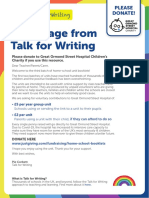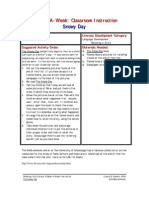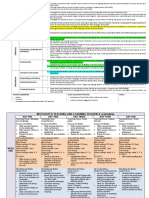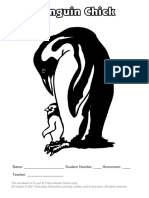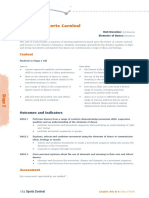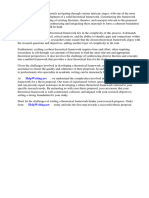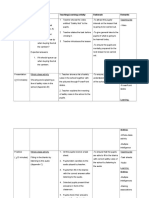Quality Practise Template Tapasa
Quality Practise Template Tapasa
Uploaded by
Deborah KapaCopyright:
Available Formats
Quality Practise Template Tapasa
Quality Practise Template Tapasa
Uploaded by
Deborah KapaCopyright
Available Formats
Share this document
Did you find this document useful?
Is this content inappropriate?
Copyright:
Available Formats
Quality Practise Template Tapasa
Quality Practise Template Tapasa
Uploaded by
Deborah KapaCopyright:
Available Formats
Template - Quality Practice – Cross Sector Examples for a QPT using a Tapasā lens
Standard Elaborations of the standard What quality practices do you use in your setting that What evidence do you use that
connect with this standard? demonstrates these quality practices?
Te Tiriti o Waitangi Understand and recognise the unique Use te reo and tikanga and link Pacific learners to identify culture. Diversity is reflected in the environment,
partnership status of tangata whenua in Aotearoa displays, language, routines
Teachers and learners prepare their own pepeha to share with each
New Zealand.
Demonstrate other. Analysed self-reflections (teacher and learner)
commitment to tangata Understand and acknowledge the at regular intervals to inform teachers of their
Pacific aspirations part of strategic planning/annual plan/allocation of efficacy.
whenuatanga and histories, heritages, languages and
resourcing.
Te Tiriti o Waitangi cultures of partners to Te Tiriti o
Planning includes context
partnership in Aotearoa Waitangi. Pacific values, culture and community reflected in the culture of the
New Zealand. school. Teachers design a curriculum that is reflective and responsive Respectful and meaningful conversations can
Practise and develop the use of te reo
so that students see themselves reflected in the school context. be observed
and tikanga Māori.
Teachers actively seeking knowledge and understanding of the Learners are confident to communicate
various Pacific contexts through learners, whānau*, community** and co-constructed conversations based on new
resources. learning – talanoa
Learners, families*** and teachers co-design what Pacific success looks Learners and families participate in events
like in an authentic New Zealand context. outside the classroom/centre
Design a curriculum that is reflective and responsive to the learners and
their communities.
Engage learners in authentic learning contexts so that they build a
strong understanding of tangata whenua and learn what partnership
looks like in their practice.
*aiga (Samoan), kainga (Tongan), tau magafaoa (Niuean), ānau (Cook
Islands Māori) , kaiga (Tokelauan)
**fa’alapotopotoga, komiuniti, tau ma’aga, matakeinanga,
whakalapotopotoga Tokelau
***aiga, fāmili, tau magafaoa, kopū tangata, kaiga
Teaching Council of Aotearoa New Zealand
Standard Elaborations of the standard What quality practices do you use in your setting that What evidence do you use that
connect with this standard? demonstrates these quality practices?
Professional Learning Inquire into and reflect on the Demonstrate a belief in collaborative learning ensuring a shared Document stories and use learning experiences
effectiveness of practice in an ongoing approach, meeting regularly with learner/staff/community** for the in classroom/centre.
Use inquiry, collaborative way, using evidence from a range of shared vision.
problem-solving and Learners are happy, engaged in motivated
sources.
professional learning to Analyse your own cultural beliefs so that you may gain an awareness of learning
improve professional Critically examine how my own other belief systems and foster an acceptance of cultural values other
Planning shows documented stories and use of
capability to impact assumptions and beliefs, including than your own.
learning experiences in classrooms/centres
on the learning and cultural beliefs, impact on practice
Reflect on learner behaviours: demeanour/participation/attendance/
achievement of all and the achievement of learners
outcomes so that you may evaluate individual learner’s participation in
learners. with different abilities and needs,
your classroom/centre.
backgrounds, genders, identities,
languages and cultures Create space and time to be a reflective practitioner
Engage in professional learning and Develop the ability to learn from formal and informal professional
adaptively apply this learning in learning opportunities directed and self-driven. Reciprocal based
practice. learning so that you support the learning of the classroom/centre and
learn from it.
Be informed by research and
innovations related to: content Create an appreciative, strengths- based pedagogy of learners.
disciplines; pedagogy; teaching for
diverse learners including learners with Be engaged in community. Ensure a wide perspective of education is
disabilities and learning support needs; evident in your classroom/centre; build the concept of lifelong learning.
and wider education matters.
Develop and connect in a learning journey.
Seek and respond to feedback
**fa’alapotopotoga, komiuniti, tau ma’aga, matakeinanga,
from learners, colleagues and other
whakalapotopotoga Tokelau
education professionals, and engage
in collaborative problem-solving and
learning-focused collegial discussions.
Teaching Council of Aotearoa New Zealand
Standard Elaborations of the standard What quality practices do you use in your setting that What evidence do you use that
connect with this standard? demonstrates these quality practices?
Professional Engage in reciprocal, collaborative Use multiple modes of communication to support the wellbeing and Communication shows you know who/what the
relationships learning-focused relationships with: learning of all learners. Pacific resources are in the community
Establish and • learners, family and whānau Consistently greet people when you see them (with a smile). Pacific ways of being, doing, and knowing is
maintain professional evident in documentation and in practice
• teaching colleagues, support staff Understand that when parents do not respond straight away, it does not
relationships and
and other professionals necessarily indicate a lack of interest. It can be a sign of respect. Engagement of Pacific parents in all areas of
behaviours focused on
school/centre
the learning and well- • agencies, groups and individuals in Create opportunities to converse in different contexts eg. fono,
being of each learner. the community. over shared food, at a beach, parks or community events (neutral Talanoa used in Fono
events). Use these opportunities to engage in talanoa with families***/
Communicate effectively with others. See and hear different languages in school/
communities**.
centre
Actively contribute, and work collegially, Know how to connect at your first meeting with parents.
in the pursuit of improving my own
and organisational practice, showing Understand learners have multiple names and identities based on
leadership, particularly in areas of relationships.
responsibility.
Invite Pacific parents to share their knowledge (pronunciation of names,
Communicate clear and accurate diversity of background etc).
assessment for learning and
Organise food for large groups and fono/events that support our
achievement information.
setting.
**fa’alapotopotoga, komiuniti, tau ma’aga, matakeinanga,
whakalapotopotoga Tokelau
***aiga, fāmili, tau magafaoa, kopū tangata, kaiga
Teaching Council of Aotearoa New Zealand
Standard Elaborations of the standard What quality practices do you use in your setting that What evidence do you use that
connect with this standard? demonstrates these quality practices?
Learning-focused Develop learning-focused relationships Know the learner, where they are from, their family background and Diversity is reflected in the environment,
culture with learners, enabling them to be their migration story. displays, language, routines
active participants in the process
Develop a culture which Correctly pronounce learners’ names. Analysed self-reflections (teacher and learner)
of learning, sharing ownership and
is focused on learning, at regular intervals to inform teachers of their
responsibility for learning. Teachers can share their own migration/origin story so that the
and is characterised efficacy.
learners feel valued and empowered to share more of themselves. The
by respect, inclusion, Foster trust, respect and cooperation
outcome of this will be an inclusive and collaborative classroom/centre Planning includes context
empathy, collaboration with and among learners so that they
environment.
and safety. experience an environment in which it Respectful and meaningful conversations can
is safe to take risks. Facilitate (listen and ask) the right questions/responses to engage be observed arners are confident noa
learners.
Demonstrate high expectations for Learners and families participate in events
the learning outcomes of all learners, Acknowledge that teaching /learning is a reciprocal relationship. outside the classroom/centre
including for those learners with
disabilities or learning support needs. Shared food is used for conversation. Come into our space and see our
hospitality.
Manage the learning setting to
ensure access to learning for all and Acknowledge people who come to school are giving us their time. It is
to maximise learners’ physical, social, our way of being*. Food is a fair exchange.
cultural and emotional safety.
Create an environment where learners
* Tū ma Āga, Ulunga’anga, Aga faka Niue, Tū tangata, Na tū ma aga
can be confident in their identities,
languages, cultures and abilities.
Develop an environment where the
diversity and uniqueness of all learners
is accepted and valued.
Meet relevant regulatory, statutory and
professional requirements.
Teaching Council of Aotearoa New Zealand
Standard Elaborations of the standard What quality practices do you use in your setting that What evidence do you use that
connect with this standard? demonstrates these quality practices?
Design for learning Select teaching approaches, resources, Gather learner and community voice when creating school and centre Planning which starts with learner and
and learning and assessment activities based curriculum, so that learners and community** are empowered. community experiences and knowledge
Design learning based based on a thorough knowledge
on curriculum and Develop meaningful relationships to co-design planning with learners Relational time away from the classroom/centre
of curriculum content, pedagogy,
pedagogical knowledge, and community to ensure culturally responsive content and pedagogy
progressions in learning and the Learners’ responses which demonstrate
assessment information and improved outcomes for all learners.
learners. emotional engagement
and an understanding of
Observe learners and talk with them about their learning.
each learner’s strengths, Gather, analyse and use appropriate Learner blogs, self-reflection classroom
interests, needs, assessment information, identifying Pacific pedagogical practices evident in curriculum and centre/ environment that show the impact of learning
identities, languages and progress and needs of learners to classroom. This will ensure that the curriculum is responsive and and next steps
cultures. design clear next steps in learning reflects that learner/whānau* knowledge is valued.
and to identify additional supports or
adaptations that may be required. Know the stories of the people in your place or context so the
curriculum is responsive, relevant and aspirational.
Design and plan culturally responsive,
evidence-based approaches which
reflect the local community and Te Tiriti
**fa’alapotopotoga, komiuniti, tau ma’aga, matakeinanga,
o Waitangi partnership in New Zealand.
whakalapotopotoga Tokelau
Harness the rich capital that learners
bring by providing culturally responsive
and engaging contexts for learners. *aiga, kainga, tau magafaoa, ānau, kaiga
Design learning informed by national
policies and priorities.
Teaching Council of Aotearoa New Zealand
Standard Elaborations of the standard What quality practices do you use in your setting that What evidence do you use that
connect with this standard? demonstrates these quality practices?
Teaching Teach in ways that ensure all learners Demonstrate the value you give to story/context, tell your story to make Respectful and meaningful reciprocal
are making sufficient progress, monitor connections, maintain interest and ongoing engagement with learners relationships
Teach and respond the extent and pace of learning, focusing to strengthen positive relationships
to learners in a Cultures are represented visually/verbally.
on equity and excellence for all.
knowledgeable and Use every opportunity to share your personal/real side. Make being Have a learning environment which reflects the
adaptive way to progress Specifically support the educational connected something you spend time on in order to ensure strong learners, as well as the teacher
their learning at an aspirations for Māori learners, taking professional relationships.
Learners who are proud, confident and willing to
appropriate depth and shared responsibility for these learners
Integrate value and respect in student and whānau* knowledge into share themselves with you
pace to achieve educational success as Māori.
classroom/centre learning by providing the time/space/opportunity.
Impact of time spent on learners evidenced
Use an increasing repertoire of teaching
Teaching is responsive to the other ‘worlds’ of the learner e.g. in organised, focused and sustained learning
strategies, approaches, learning
sport, cultural and community events (by watching, listening and activity
activities, technologies and assessment
participating).
for learning strategies and modify these Work which reflects student choice, interest,
in response to the needs of individuals Recognise and undercut stereotypical/default ideas about Pacific background etc
and groups of learners. people by exploring the diverse histories of our Pacific nations
Whānau* are engaged as evidenced in their
(including myths and legends).
Provide opportunities and support for communication with the school/centre and
learners to engage with, practise and Meet with families*** outside of school to engage and learn what is in their understanding of the progress their
apply learning to different contexts and working for them, what’s not working and changing accordingly. This learners are making
make connections with prior learning. could include community events/home visits.
Teach in ways which enable learners to Provide opportunities for learners’ communities** to come into
learn from one another, to collaborate, *aiga, kainga, tau magafaoa, ānau, kaiga
classroom/school so that they feel validated and included. Be a learner.
to self-regulate, and to develop agency
over their learning. Engage in informal conversations with parents, whānau to strengthen
relationships.
Ensure learners receive ongoing
feedback and assessment information
and support them to use this
**fa’alapotopotoga, komiuniti, tau ma’aga, matakeinanga,
information to guide further learning.
whakalapotopotoga Tokelau
***aiga, fāmili, tau magafaoa, kopū, kaiga
Teaching Council of Aotearoa New Zealand
You might also like
- IKAN Forms NZ MathsDocument1 pageIKAN Forms NZ Maths우리No ratings yet
- Big Green LessonDocument6 pagesBig Green LessonEarl Matthew ValdezNo ratings yet
- Grandad's Gifts S2Document30 pagesGrandad's Gifts S2S TANCRED100% (1)
- Lesson Plan Guide: Specific Measurable Attainable Relevant - TimeDocument5 pagesLesson Plan Guide: Specific Measurable Attainable Relevant - TimeKory PauliniNo ratings yet
- Kristina Sue Manukura Our Code Our Standards Appraisal Portfolio 2017 1Document9 pagesKristina Sue Manukura Our Code Our Standards Appraisal Portfolio 2017 1api-374593974No ratings yet
- Literacy Planning Pex4Document6 pagesLiteracy Planning Pex4api-483164681No ratings yet
- Dragon Hunter S3Document22 pagesDragon Hunter S3S TANCREDNo ratings yet
- Emma M - Roberts Lesson Plan Template 1Document3 pagesEmma M - Roberts Lesson Plan Template 1api-312742046No ratings yet
- Heinemann Literature: WWW - Heinemann.co - UkDocument54 pagesHeinemann Literature: WWW - Heinemann.co - Ukdaniel adamsNo ratings yet
- Talk For Writing - Y2-RainbowsDocument24 pagesTalk For Writing - Y2-RainbowsChong Beng LimNo ratings yet
- pm4 Recount FluentDocument1 pagepm4 Recount Fluentapi-145532104No ratings yet
- Quality Practise Templat TapasaDocument5 pagesQuality Practise Templat Tapasaapi-399088937100% (1)
- Snowy Day LessonDocument9 pagesSnowy Day LessonAngeliquita MaríaNo ratings yet
- Lit Y5Autumn P Unit1ADocument8 pagesLit Y5Autumn P Unit1APeta WrightNo ratings yet
- You Read To Me I Read To You2Document8 pagesYou Read To Me I Read To You2Carolina GarcíaNo ratings yet
- Alex CV Ais W Cover LetterDocument4 pagesAlex CV Ais W Cover Letterapi-258699610No ratings yet
- English Program Term 2Document5 pagesEnglish Program Term 2api-247083785No ratings yet
- Dear MR Henshaw LPSampleDocument36 pagesDear MR Henshaw LPSampleElizabeth Vanessa Santisteban MuñozNo ratings yet
- Pourquoi Tale Task 2Document5 pagesPourquoi Tale Task 2Adam AzlanNo ratings yet
- Literacy Lesson Persuasive Writing - Lesson 3 6Document5 pagesLiteracy Lesson Persuasive Writing - Lesson 3 6api-354629458No ratings yet
- Talk For Writing - Y3-Unicorn-FDocument33 pagesTalk For Writing - Y3-Unicorn-FChong Beng LimNo ratings yet
- Mastery Assessment Y3Document29 pagesMastery Assessment Y3sonuandsonuNo ratings yet
- Thematic Unit PlanDocument10 pagesThematic Unit Planapi-330392338No ratings yet
- Books For Grades 1 and 2Document2 pagesBooks For Grades 1 and 2Anonymous K9cINmNNo ratings yet
- Fifth s5p1 Physical and Chemical ChangesDocument14 pagesFifth s5p1 Physical and Chemical ChangesJordan100% (1)
- Ethan Sais CTL Assessment Task 1Document30 pagesEthan Sais CTL Assessment Task 1api-357549157No ratings yet
- Books For Kindergarten: Reader)Document2 pagesBooks For Kindergarten: Reader)Anonymous K9cINmN100% (1)
- Suspense ToolkitDocument2 pagesSuspense ToolkitEddie ZhouNo ratings yet
- The BullyDocument4 pagesThe BullyTevin VincentNo ratings yet
- Where The Forest Meets The Sea Sample Lesson PlanDocument29 pagesWhere The Forest Meets The Sea Sample Lesson PlanJASMINE KAUR100% (2)
- Charlotte's Web.Document4 pagesCharlotte's Web.Jose Francisco Ruiz Vazquez MNNo ratings yet
- Pannikin and Pinta VWDocument2 pagesPannikin and Pinta VWapi-232153749No ratings yet
- Let The Celebrations Begin S3Document18 pagesLet The Celebrations Begin S3S TANCREDNo ratings yet
- Interactive Read AloudDocument3 pagesInteractive Read Aloudapi-526388634No ratings yet
- Best Books Years 3Document3 pagesBest Books Years 3Magelican0% (1)
- PLT Lag g06 LB Eng NaDocument160 pagesPLT Lag g06 LB Eng NaAlton MadyaraNo ratings yet
- English FPDDocument8 pagesEnglish FPDapi-306743539No ratings yet
- Charlie and Mouse Teacher GuideDocument20 pagesCharlie and Mouse Teacher GuideChronicleBooksNo ratings yet
- Literacy Unit Plan CorrectionsDocument12 pagesLiteracy Unit Plan Correctionsapi-311313472No ratings yet
- Writing Term 4Document8 pagesWriting Term 4api-364740483No ratings yet
- Yde Unit PlanDocument2 pagesYde Unit Planapi-474709749No ratings yet
- A Novel Review: FrindleDocument4 pagesA Novel Review: FrindlejobbydudeNo ratings yet
- 2nd Grade Alliteration and RhymeDocument3 pages2nd Grade Alliteration and Rhymeapi-350861920No ratings yet
- S2 English Scope and Sequence ChecklistDocument17 pagesS2 English Scope and Sequence ChecklistS TANCREDNo ratings yet
- Eng 4Document8 pagesEng 4api-350463121No ratings yet
- Dark Ages Lesson PlanDocument3 pagesDark Ages Lesson PlanJack Redding100% (1)
- Lesson Plan For TeachingDocument5 pagesLesson Plan For Teachingapi-458162814No ratings yet
- Plcmaturitymatrix 1Document2 pagesPlcmaturitymatrix 1api-583648189No ratings yet
- Mirror S2Document22 pagesMirror S2S TANCRED100% (1)
- Montessori Lesson Plan 3Document3 pagesMontessori Lesson Plan 3api-434488792No ratings yet
- Talk For Writing - Y5-Elves-FDocument27 pagesTalk For Writing - Y5-Elves-FChong Beng LimNo ratings yet
- Poetry UnitDocument44 pagesPoetry Unitapi-352484036No ratings yet
- Codesign 01introductionDocument8 pagesCodesign 01introductionbshaddox2837100% (1)
- Lesson Plan Form - OobleckDocument4 pagesLesson Plan Form - OobleckSaraNo ratings yet
- 00 Penguin Chick WorkbookDocument10 pages00 Penguin Chick Workbookapi-546418402No ratings yet
- Ubd Term 3 Unit Planner Year 7 EnglishDocument4 pagesUbd Term 3 Unit Planner Year 7 Englishapi-319055998No ratings yet
- Dance Stage 2 Sports CarnivalDocument5 pagesDance Stage 2 Sports Carnivalapi-459326447No ratings yet
- Lesson Plan-Close Reading TitanicDocument5 pagesLesson Plan-Close Reading Titanicapi-322794371No ratings yet
- U2W5 One Good Turn Deserves AnotherDocument140 pagesU2W5 One Good Turn Deserves AnotherJaviera BlameyNo ratings yet
- Andrea Brown - Resume - 2023Document2 pagesAndrea Brown - Resume - 2023api-663101658No ratings yet
- Checklist For IDEA Lesson ExemplarDocument2 pagesChecklist For IDEA Lesson ExemplarEmerson Nunez100% (1)
- Reading With Purpose WebsiteDocument48 pagesReading With Purpose Websiteapi-252238682No ratings yet
- PPSSHDocument3 pagesPPSSHAldrin M. ObiasNo ratings yet
- After Bawa Garba Relocating Reflective PracticeDocument10 pagesAfter Bawa Garba Relocating Reflective PracticezoeplaydonNo ratings yet
- Pulo Senior High School: Department of EducationDocument4 pagesPulo Senior High School: Department of Educationcristina maquintoNo ratings yet
- Writing Your Own Teaching PhilosophyDocument4 pagesWriting Your Own Teaching PhilosophyJuan Camilo Galeano SánchezNo ratings yet
- Monthly Supervisory and Itinerary APRIL 2024Document58 pagesMonthly Supervisory and Itinerary APRIL 2024david john uberaNo ratings yet
- What Is Instructional Materials-Educ 118Document6 pagesWhat Is Instructional Materials-Educ 118Diane Cornelia100% (1)
- Detailed Evidence ExamplesDocument24 pagesDetailed Evidence ExamplesPeter RileyNo ratings yet
- A Detailed Lesson Plan in MathematicsDocument7 pagesA Detailed Lesson Plan in MathematicsNicole UganNo ratings yet
- Accomplishement SLAC 2021Document8 pagesAccomplishement SLAC 2021jamel mayorNo ratings yet
- Theoretical Framework Thesis ProposalDocument8 pagesTheoretical Framework Thesis Proposaljennifermooreknoxville100% (2)
- By The End of The Lesson, Pupils Should Be Able ToDocument2 pagesBy The End of The Lesson, Pupils Should Be Able ToAzwane AdnanNo ratings yet
- HR Manager CVDocument3 pagesHR Manager CVMangsuan mungcheshamNo ratings yet
- 3B Listening & Speaking Unit 6Document6 pages3B Listening & Speaking Unit 6John GanNo ratings yet
- MmhprojectunitplanDocument3 pagesMmhprojectunitplanapi-300969654No ratings yet
- TNHS BL LCOPparts 5 AnnexDocument21 pagesTNHS BL LCOPparts 5 AnnexRONNEL MASNo ratings yet
- Final Field Experience Summary - Alicia BirchDocument6 pagesFinal Field Experience Summary - Alicia Birchapi-315487341No ratings yet
- Community Service Reflection PaperDocument2 pagesCommunity Service Reflection Paperapi-482258096No ratings yet
- Lesson Plan: First Observation (MST)Document5 pagesLesson Plan: First Observation (MST)api-329103312No ratings yet
- Maths Lesson 4Document3 pagesMaths Lesson 4api-346324074No ratings yet
- 5E Model For Leson Plan PreparationDocument21 pages5E Model For Leson Plan PreparationOrigen Peralta AccadNo ratings yet
- Program HistoquizDocument3 pagesProgram HistoquizLeeMcQ_78100% (1)
- Least Restrictive Environment: MidtermDocument14 pagesLeast Restrictive Environment: MidtermJam SyNo ratings yet
- Laes Monitoring ToolDocument4 pagesLaes Monitoring ToolMelofe A. AlabadoNo ratings yet
- Edu 536Document8 pagesEdu 536Mauie EmasNo ratings yet
- Holistic Education Need of An HourDocument7 pagesHolistic Education Need of An HourSathya Narayanan Sr.No ratings yet
- Listening Lesson 70Document2 pagesListening Lesson 70WISH1441No ratings yet









